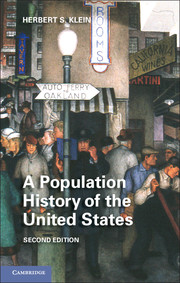Book contents
- Frontmatter
- Contents
- Graphs, Maps, and Tables
- Introduction to the Second Edition
- Introduction to the First Edition
- 1 Paleo–Indians, Europeans, and the Settlement of America
- 2 Colonization and Settlement of North America
- 3 The Early Republic to 1860
- 4 The Creation of an Industrial and Urban Society, 1860–1914
- 5 The Evolution of a Modern Population, 1914–1945
- 6 The Baby Boom and Bust and the New New Immigrants, 1945–1970
- 7 An Advanced Industrial Society, 1970–2011
- Appendix Tables, Graphs, and Maps
- Bibliography
- Index
- References
5 - The Evolution of a Modern Population, 1914–1945
Published online by Cambridge University Press: 05 June 2012
- Frontmatter
- Contents
- Graphs, Maps, and Tables
- Introduction to the Second Edition
- Introduction to the First Edition
- 1 Paleo–Indians, Europeans, and the Settlement of America
- 2 Colonization and Settlement of North America
- 3 The Early Republic to 1860
- 4 The Creation of an Industrial and Urban Society, 1860–1914
- 5 The Evolution of a Modern Population, 1914–1945
- 6 The Baby Boom and Bust and the New New Immigrants, 1945–1970
- 7 An Advanced Industrial Society, 1970–2011
- Appendix Tables, Graphs, and Maps
- Bibliography
- Index
- References
Summary
The period from the beginning of World War Ⅰ to the end of World War II is marked by several major developments. Probably the most intense of these demographic changes is the very rapid and sustained decline in mortality. Mortality rates began to fall in the last decades of the 19th century but then started to decline at an unprecedented pace. This trend was spearheaded by a precipitous drop in deaths from infectious diseases, which affected all groups within the population but was most dramatically experienced by the very youngest persons in the population. Deaths of infants and of young children, previously one of the most vulnerable groups in terms of mortality, declined at a faster rate than for all other age groups. The result of this change in traditional mortality was a steady and rapid rise in life expectancy for every new generation born in this period. The cause for this unprecedented and massive decline in mortality is much debated, but it was undoubtedly related to important changes in sanitation and later to the introduction of new medical practices. Chlorine treatment of water became the norm in this period and proper waste and garbage disposal in the major urban centers was now part of every municipal agenda. Public health campaigns organized by newly founded city and state health departments also led to improvements in the preservation and quality of food, and the pasteurization of milk and other dairy products became standard practice everywhere. Finally, immunization now became a basic part of public health systems. Up to the 1880s, there was only one vaccine available, for smallpox; there now appeared a number of crucial vaccines that were quickly applied to the public. In the last decade of the 19th century vaccines were developed for rabies, typhoid, cholera, and the plague. Then came whooping cough vaccines in 1913 and, in the decade of the 1920s, vaccines for diphtheria, tetanus, and tuberculosis. It now became the norm to vaccinate all children, a process that expanded both nationally and internationally in every subsequent decade.
- Type
- Chapter
- Information
- A Population History of the United States , pp. 129 - 154Publisher: Cambridge University PressPrint publication year: 2012



